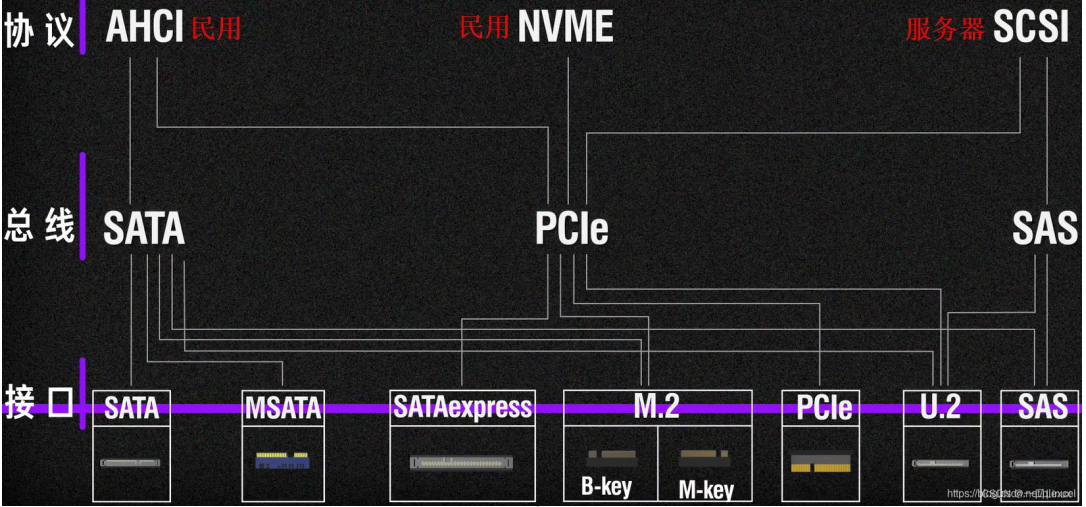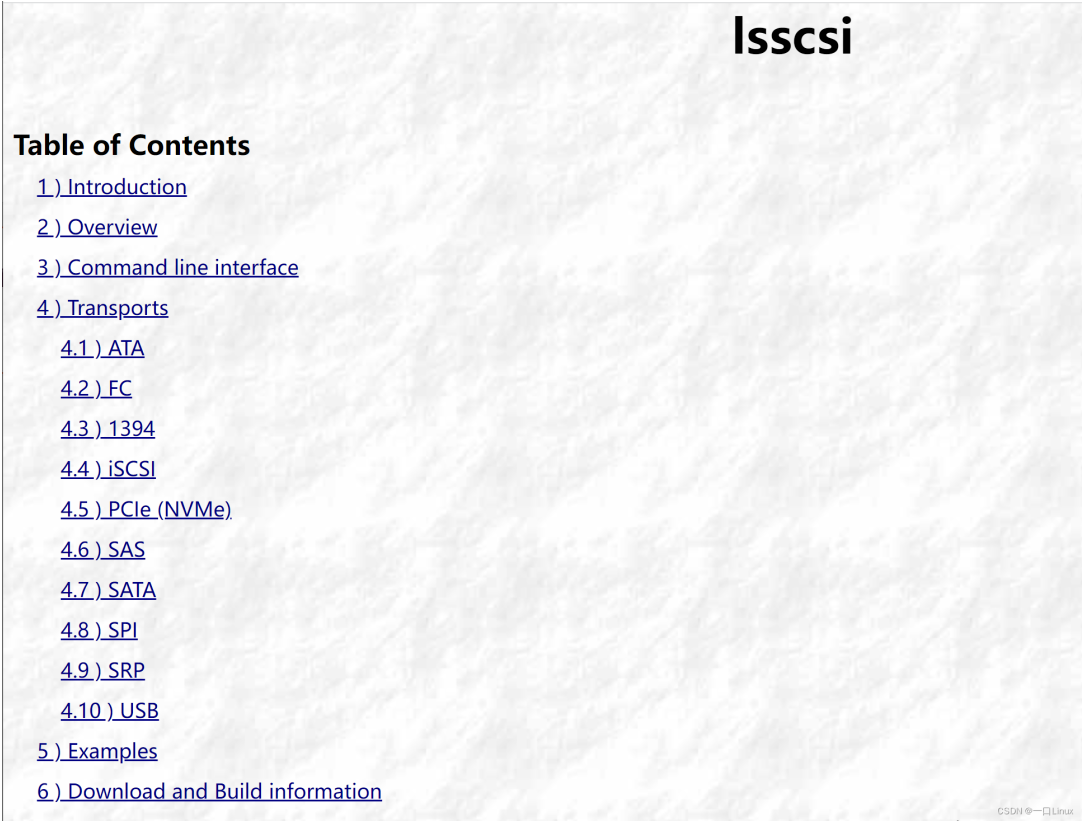Detailed explanation of Linux command lsscsi
To understand the lsscsi command, first we need to understand what SCSI is and common hard disk interfaces and common hard disk parameters.
1. What is SCSI?
SCSI (Small Computer System Interface) is a complete data transfer protocol, which is mainly used to transfer commands, status and block data between the host and storage devices. Among various storage technologies, SCSI technology is the most important pillar.
The SCSI protocol is located between the operating system and external resources. It has a series of functional components. The operating system's I/O operations on external devices (such as disks, tapes, CD-ROMs, printers , etc.) can be implemented through the SCSI protocol. Typically, the SCSI protocol is embedded in the device driver or the host adapter's onboard logic.

2. Common hard disk interfaces
1. Hard drive with IDE interface
Its English name: Integrated Drive Electronics, the common 2.5-inch IDE hard disk interface, its original meaning refers to the hard disk drive that integrates the "hard disk controller" and the "disk body".
IDE represents a type of hard disk, but in actual applications, people are also accustomed to using IDE to refer to the earliest IDE type hard disk ATA-1. This type of interface has been eliminated with the development of interface technology. , and then developed into more types of hard disk interfaces, such as ATA, Ultra ATA, DMA, Ultra DMA and other interfaces, which are all IDE hard disks.
Its characteristics are: low price, strong compatibility, high cost performance, slow data transmission, does not support hot swapping, etc.

2. SCSI interface hard disk
SCSI is not an interface specifically designed for hard disks. It is a high-speed data transmission technology widely used on minicomputers.
The SCSI interface has the advantages of wide application range, multi-tasking, large bandwidth, low CPU usage, and hot-swappability. However, the higher price makes it difficult to be as popular as IDE hard drives, so SCSI hard drives are mainly used in medium and , high-end servers and high-end workstations.
Its characteristics are: high transmission rate, good reading and writing performance, can connect multiple devices, and can support hot swapping, but the price is relatively expensive.

3. SATA interface type
The English name is: Serial Advanced Technology Attachment. Hard drives using the SATA (Serial ATA) port are also called serial hard drives and are the future trend of PC hard drives.
Serial ATA uses a serial connection method. The Serial ATA bus uses an embedded clock signal and has stronger error correction capabilities. Compared with the past, its biggest difference is that it can transmit instructions (not just data). Check and automatically correct errors if found, which greatly improves the reliability of data transmission.
The serial interface also has the advantages of simple structure and support for hot swapping.

3. lsscsi command
lsscsi lists scsi/sata device information, such as hard drives and optical drives.
1. lsscsi command installation
-bash: lsscsi command not found #Debian apt-get install lsscsi #Ubuntu apt-get install lsscsi #Alpine apk add lsscsi #Arch Linux pacman -S lsscsi #Kali Linux apt-get install lsscsi #CentOS yum install lsscsi #Fedora dnf install lsscsi #Raspbian apt-get install lsscsi #Docker docker run cmd.cat/lsscsi lsscsi
2. lsscsi command English manual
Detailed command description address
https://sg.danny.cz/scsi/lsscsi.html

2. Command format
lsscsi command syntax:
lsscsi [选项] [H:C:T:L]
lsscsi command options:
| Options | meaning |
|---|---|
| -g | Display SCSI common device file name |
| -k | Display kernel name instead of device node name |
| -d | Display the primary and secondary numbers of the device node |
| -H | List the SCSI hosts currently connected to the system instead of the SCSI devices |
| -l | Display additional information for each SCSI device (host) |
| -c | Relative to the output of executing cat /proc/scsi/scsi command |
| -p | Show additional data integrity (protection) information |
| -t | Display transmission information |
| -L | Display additional information in the form of "attribute name=value" |
| -v | Output directory name when information is found |
| -y | Assume that sysfs is mounted at the specified path instead of the default "/sys" |
| -s | Display capacity size. |
| -c | Display the default information with the full name. |
| -d | Display the device primary and secondary device numbers. |
| -g | Display the corresponding sg device name. |
| -H | Display host controller list, -Hl, -Hlv. |
| -l | Display related attributes, -ll,-llll=-L. |
| -v | Display the directory where the device properties are located. |
| -x | Display the lun number in hexadecimal. |
| -p | Output DIF,DIX protection type. |
| -P | Output valid protection mode information. |
| -i | Display udev related attributes |
| -w | Show WWN |
| -t | Display corresponding transmission information (ATA, FC, SBP, ISCSI, SPI, SAS, SATA, USB), -Ht, -tl. (including sas address) |
3. 结果含义

四、命令举例
lsscsi 列出所有 SCSI 设备:
peng@ubuntu:~$ lsscsi [3:0:0:0] cd/dvd NECVMWar VMware SATA CD01 1.00 /dev/sr0 [32:0:0:0] disk VMware, VMware Virtual S 1.0 /dev/sda
lsscsi -L列出所有具有详细属性的 SCSI 设备:
peng@ubuntu:~$ lsscsi -L [3:0:0:0] cd/dvd NECVMWar VMware SATA CD01 1.00 /dev/sr0 device_blocked=0 iocounterbits=32 iodone_cnt=0x229 ioerr_cnt=0x4 iorequest_cnt=0x23a queue_depth=1 queue_type=none scsi_level=6 state=running timeout=30 type=5 [32:0:0:0] disk VMware, VMware Virtual S 1.0 /dev/sda device_blocked=0 iocounterbits=32 iodone_cnt=0x37370 ioerr_cnt=0x3 iorequest_cnt=0x37370 queue_depth=32 queue_type=simple scsi_level=3 state=running timeout=180 type=0
lsscsi -s列出所有具有人类可读磁盘容量的 SCSI 设备:
peng@ubuntu:~$ lsscsi -s [3:0:0:0] cd/dvd NECVMWar VMware SATA CD01 1.00 /dev/sr0 - [32:0:0:0] disk VMware, VMware Virtual S 1.0 /dev/sda 536GB
五、其他
1. Linux下scsi相关文件节点
/proc/scsi/
peng@ubuntu:~$ cd /proc/scsi/ peng@ubuntu:/proc/scsi$ ls device_info mptspi scsi sg peng@ubuntu:/proc/scsi$ cat scsi Attached devices: Host: scsi32 Channel: 00 Id: 00 Lun: 00 Vendor: VMware, Model: VMware Virtual S Rev: 1.0 Type: Direct-Access ANSI SCSI revision: 02 Host: scsi3 Channel: 00 Id: 00 Lun: 00 Vendor: NECVMWar Model: VMware SATA CD01 Rev: 1.00 Type: CD-ROM ANSI SCSI revision: 05
/sys/class/scsi_host
peng@ubuntu:/sys/class/scsi_host$ ls host0 host12 host16 host2 host23 host27 host30 host5 host9 host1 host13 host17 host20 host24 host28 host31 host6 host10 host14 host18 host21 host25 host29 host32 host7 host11 host15 host19 host22 host26 host3 host4 host8
/sys/class/scsi_device
peng@ubuntu:/sys/class/scsi_device$ ls 3:0:0:0 32:0:0:0
/sys/class/scsi_disk
peng@ubuntu:/sys/class/scsi_disk$ ls 32:0:0:0
/sys/class/scsi_generic
peng@ubuntu:/sys/class/scsi_generic$ ls sg0 sg1
/sys/bus/scsi
peng@ubuntu:/sys/bus/scsi$ ls devices drivers drivers_autoprobe drivers_probe uevent peng@ubuntu:/sys/bus/scsi/devices$ ls 3:0:0:0 host11 host16 host20 host25 host3 host5 target3:0:0 32:0:0:0 host12 host17 host21 host26 host30 host6 target32:0:0 host0 host13 host18 host22 host27 host31 host7 host1 host14 host19 host23 host28 host32 host8 host10 host15 host2 host24 host29 host4 host9
其中target3:0:0
对应
host:bus:id:lun
2. Linux 开启 SCSI 日志调试功能
- 1.编译选项中需开启 CONFIG_SCSI_LOGGING

- 2.该编译选项说明
drivers/scsi/Kconfig:213 config SCSI_LOGGING bool "SCSI logging facility" depends on SCSI ---help--- This turns on a logging facility that can be used to debug a number of SCSI related problems. If you say Y here, no logging output will appear by default, but you can enable logging by saying Y to "/proc file system support" and "Sysctl support" below and executing the command echo > /proc/sys/dev/scsi/logging_level where is a four byte value representing the logging type and logging level for each type of logging selected. There are a number of logging types and you can find them in the source at . The logging levels are also described in that file and they determine the verbosity of the logging for each logging type. If you say N here, it may be harder to track down some types of SCSI problems. If you say Y here your kernel will be somewhat larger, but there should be no noticeable performance impact as long as you have logging turned off.
- 3.logging 类型源码文件位置(有说明)
-> drivers\scsi\scsi_logging.h
- 4.使用说明
/* * Note - the initial logging level can be set here to log events at boot time. * After the system is up, you may enable logging via the /proc interface. */ unsigned int scsi_logging_level; #if defined(CONFIG_SCSI_LOGGING) EXPORT_SYMBOL(scsi_logging_level); #endif
scsi_logging_level 被定义成int类型(32bit),该机制使用了30个bit,从低位到高位每3bit为一个logging level从SCSI_LOG_ERROR_SHIFT到SCSI_LOG_IOCTL_SHIFT(SCSI_LOG_XXX_SHIFT为不同level的移位数),每个level使用的bit数都是3,所以 SCSI_LOG_XXX_BITS 均为3
- 5.scsi_logging_level 值可以在 boot 命令行设置也可以开启设备后在 /proc 文件系统中设置:
-1 - Enable scsi events to syslog. // 开启所有scsi log 0 - Disable scsi events to syslog. // 关闭所有scsi log
命令:
echo 0/-1 > /proc/sys/dev/scsi/logging_level
The above is the detailed content of Detailed explanation of Linux command lsscsi. For more information, please follow other related articles on the PHP Chinese website!

Hot AI Tools

Undresser.AI Undress
AI-powered app for creating realistic nude photos

AI Clothes Remover
Online AI tool for removing clothes from photos.

Undress AI Tool
Undress images for free

Clothoff.io
AI clothes remover

Video Face Swap
Swap faces in any video effortlessly with our completely free AI face swap tool!

Hot Article

Hot Tools

Notepad++7.3.1
Easy-to-use and free code editor

SublimeText3 Chinese version
Chinese version, very easy to use

Zend Studio 13.0.1
Powerful PHP integrated development environment

Dreamweaver CS6
Visual web development tools

SublimeText3 Mac version
God-level code editing software (SublimeText3)

Hot Topics
 What computer configuration is required for vscode
Apr 15, 2025 pm 09:48 PM
What computer configuration is required for vscode
Apr 15, 2025 pm 09:48 PM
VS Code system requirements: Operating system: Windows 10 and above, macOS 10.12 and above, Linux distribution processor: minimum 1.6 GHz, recommended 2.0 GHz and above memory: minimum 512 MB, recommended 4 GB and above storage space: minimum 250 MB, recommended 1 GB and above other requirements: stable network connection, Xorg/Wayland (Linux)
 Linux Architecture: Unveiling the 5 Basic Components
Apr 20, 2025 am 12:04 AM
Linux Architecture: Unveiling the 5 Basic Components
Apr 20, 2025 am 12:04 AM
The five basic components of the Linux system are: 1. Kernel, 2. System library, 3. System utilities, 4. Graphical user interface, 5. Applications. The kernel manages hardware resources, the system library provides precompiled functions, system utilities are used for system management, the GUI provides visual interaction, and applications use these components to implement functions.
 vscode terminal usage tutorial
Apr 15, 2025 pm 10:09 PM
vscode terminal usage tutorial
Apr 15, 2025 pm 10:09 PM
vscode built-in terminal is a development tool that allows running commands and scripts within the editor to simplify the development process. How to use vscode terminal: Open the terminal with the shortcut key (Ctrl/Cmd). Enter a command or run the script. Use hotkeys (such as Ctrl L to clear the terminal). Change the working directory (such as the cd command). Advanced features include debug mode, automatic code snippet completion, and interactive command history.
 How to check the warehouse address of git
Apr 17, 2025 pm 01:54 PM
How to check the warehouse address of git
Apr 17, 2025 pm 01:54 PM
To view the Git repository address, perform the following steps: 1. Open the command line and navigate to the repository directory; 2. Run the "git remote -v" command; 3. View the repository name in the output and its corresponding address.
 Where to write code in vscode
Apr 15, 2025 pm 09:54 PM
Where to write code in vscode
Apr 15, 2025 pm 09:54 PM
Writing code in Visual Studio Code (VSCode) is simple and easy to use. Just install VSCode, create a project, select a language, create a file, write code, save and run it. The advantages of VSCode include cross-platform, free and open source, powerful features, rich extensions, and lightweight and fast.
 How to run java code in notepad
Apr 16, 2025 pm 07:39 PM
How to run java code in notepad
Apr 16, 2025 pm 07:39 PM
Although Notepad cannot run Java code directly, it can be achieved by using other tools: using the command line compiler (javac) to generate a bytecode file (filename.class). Use the Java interpreter (java) to interpret bytecode, execute the code, and output the result.
 What is the main purpose of Linux?
Apr 16, 2025 am 12:19 AM
What is the main purpose of Linux?
Apr 16, 2025 am 12:19 AM
The main uses of Linux include: 1. Server operating system, 2. Embedded system, 3. Desktop operating system, 4. Development and testing environment. Linux excels in these areas, providing stability, security and efficient development tools.
 How to run sublime after writing the code
Apr 16, 2025 am 08:51 AM
How to run sublime after writing the code
Apr 16, 2025 am 08:51 AM
There are six ways to run code in Sublime: through hotkeys, menus, build systems, command lines, set default build systems, and custom build commands, and run individual files/projects by right-clicking on projects/files. The build system availability depends on the installation of Sublime Text.






